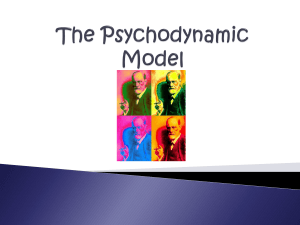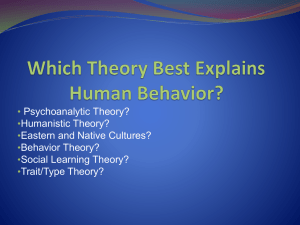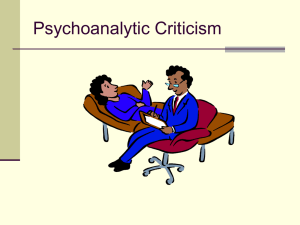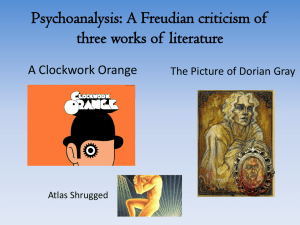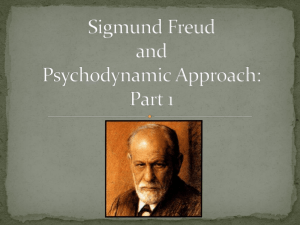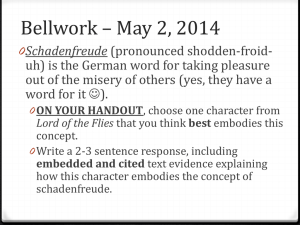Separating the Ego from the Superego
advertisement
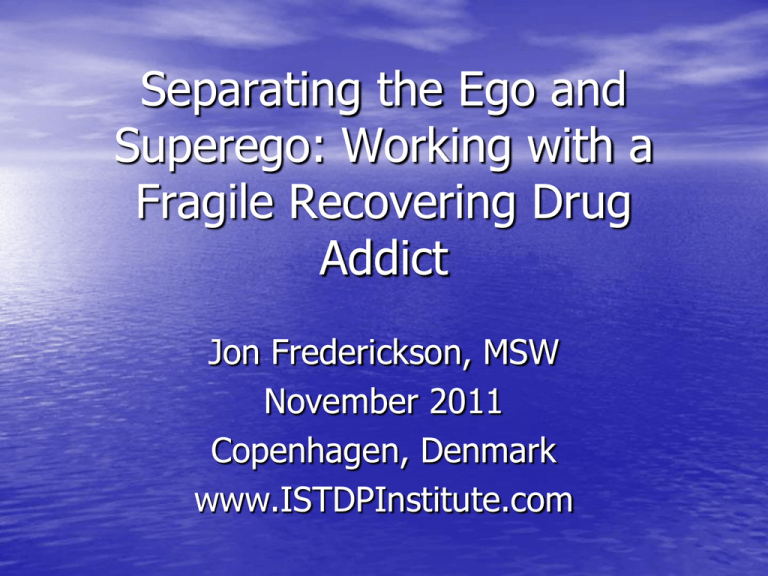
Separating the Ego and Superego: Working with a Fragile Recovering Drug Addict Jon Frederickson, MSW November 2011 Copenhagen, Denmark www.ISTDPInstitute.com Psychodiagnosis 3) Identify Defences 2) Monitor Anxiety Unconscious Defences Unconscious Anxiety Unconscious Feelings 1) Invite feeling Levels of SE Pathology • Fragile patients • High Resistance • Moderate Resistance • Low Resistance ISTDP and the Superego • Pressure to Feeling • Defense identification • Challenge Defenses • Resistance in the T • Confront the Transference Resistance • Breakthrough Modifications of ISTDP Technique I • Ten Have de Labije: mobilization of ego adaptive capacity and separation of ego and superego prior to the phase of pressure. Immediately point out the superego basis of defenses and the superego basis of the non-therapeutic relationship the patient tries to establish. Ideal Ego Adaptive Capacity • Observing ego: anxiety, feeling and defense • Attentive ego: anxiety, feeling and defense. • Ability to differentiate feeling from anxiety, • • feeling from defense, and anxiety from defense. Able to see causality: feeling evokes anxiety which evokes defenses. Dystonic: able to distinguish healthy ego from unhealthy part of the superego; able to feel guilt and grief over the cost of the defenses; able to turn against destructive defenses. Do we see ego or identification with the superego? • I don’t observe my feelings or anxiety. • I don’t pay attention to my F, A, or D. • I don’t differentiate feeling from anxiety: I strangle and punish myself with anxiety. • I don’t differentiate myself from defense: I identify with my destructive defenses. • Causality? My defenses don’t cause my presenting problems; other people do. Do we see ego or identification with the Superego? • I can’t help it = I’m identified with my superego, my healthy ego is in you, so get to work and see if you can overcome the team of me and my superego against you. • My defenses aren’t destructive; they’re what make me feel safe. Separation of Ego and Superego • Confront patient with her identification with the • • • • superego Differentiate the healthy part of the ego from the unhealthy part of the superego Restructure ego capacity; differentiate the triangle and see causality Challenge patient to stand up to the SE Help patient bear increasing levels of feeling with manageable anxiety. Modifications of ISTDP Technique II • Robert Neborsky: distinguish between the superego based insecure attachment and the secure attachment offered by the therapist; point out the function of superego affects; point out the superego based relationship each defense invites; point out the superego basis of projected transference images; metaphors to help patients with problems of symbolization. Modifications of ISTDP Technique III • Allen Kalpin: attention as the basis of a secure attachment, inattention as evidence of superego activity; use of cognitive therapy techniques to help patients differentiate feeling from defenses (pathological beliefs), see correct causality, differentiate ego from superego habit. In other words, develop all ego capacities necessary prior to the phase of challenge. Modifications of ISTDP Technique IV • Each of these innovators understands the difference between a principle and a technique. • Principle: separate ego and superego. • Technique: any technique from any school of thought may used as long as it serves the fundamental principle. Viewing Defenses and the Alliance through the Prism of the Superego Defense: patient talks over and ignores her anxiety. [identifies with superego] Relationship: I invite you to join me in ignoring my anxiety. [be a superego to me] Object relation: dismissive parent and suffering, ignored child. Attachment pattern: insecure, avoidant Superego based Interventions • Defense: Do you notice you ignore your anxiety right now? • Relationship: Do you notice that you are inviting me to pay attention to your friend instead of to you right now? That you invite me to ignore you? • Object relation: What kind of therapist would I be if I joined you in ignoring you? Superego based Interventions II • “I don’t know.” “Is that really true, or is that a way you have of ignoring yourself?” • “Do you notice that you say that before you even give yourself a chance to pay attention to yourself, before you even let yourself think? Is that a way you have of not paying closer attention to yourself?” Task versus Superego Activity • You will need to take a stand against that self dismissal of your emotions. Otherwise, we will not be successful. • So who is going to be in charge here--you, or these destructive habits? • Ego or superego? • Secure attachment or insecure? • New relationship or repetition of trauma bond. Why the patient does not see the superego: Externalization! • She obviously doesn’t care about me, because if she did she wouldn’t wear perfume when I come to visit. • You obviously don’t care about you, because if you did you wouldn’t wear her perfume by staying there for hours while having that allergic reaction. Externalization: the superego’s best friend • Mistaken causality: she ignores me. • True causality: When angry, I punish myself by • staying by her perfume and inflicting an allergy upon myself. Then I blame her for my choice to stay and have an allergic reaction. As long as the patient projects his superego onto others, he does not see how he creates his suffering. His suffering is “caused” by people in the external world. The patient remains blind to the ways the superego inside him causes his suffering. Thus, the patient chronically misunderstands causality. Externalization: the superego’s best friend II • Problem of causality: • Mistaken causality: she made me put $100,000 into her • • • bank account. True causality: I was angry with her, punished myself by putting $100,000 into her account, then blamed her for my decision. Anger; A; self punishment; projection of superego. If I accuse her of punishing me, I can ignore how I punish myself, thus allowing my suffering to continue. This is why blame and complaining are considered defenses in ISTDP. Externalization: The superego’s best friend III • Mistaken causality: He hit me twice! • True causality: enraged with his brother, he punished himself by accepting the second blow, then blamed his brother. • Anger; A; self punishment; blame. • He hit you once. The second time you hit yourself, using his arm. Impact of Superego Pathology on Ego Adaptive Capacity I • High anxiety prevents the mobilization of an observing or attentive ego. Since she can’t see her defenses, she can’t turn against them. • Identification with a neglectful parent leads patient not to pay attention to her anxiety or feelings. Since she does not pay attention to her anxiety, she can’t regulate it. Thus, she remains tortured by anxiety. Impact of Superego Pathology on Ego Adaptive Capacity II • Since the defenses are so chronic and • automatic, the patient believes that is who she is. Fusion of ego and superego. The patient cannot see causality: feeling triggers anxiety which triggers defenses which cause her presenting problems. As a result, the patient has a mistaken theory of causality: defenses are the solution to my problem, not its cause. Separating Ego and Superego • Identification with the superego: “that’s the way • I am.” “No, that’s the way you deal with your feelings.” “Do you remember when you saw your babies? Did they hate themselves? Did they hurt themselves? Right. See, you have to learn to do crazy stuff like that. So those babies? That’s you. This self hate and all that, those are just habits you picked up along the way. They have as little to do with you as a cancer tumor does.” Separating Ego and Superego II • Inability to differentiate observing ego from superego affects. “I am anxious.” “Do you notice how it’s as if a policeman comes in the room right now to paralyze you with this anxiety? How this anxiety comes in to attack you right now? This must be upsetting how this anxiety does such a number to you.” Superego Affects • Anxiety, guilt, and shame. • The key is not the historical origin, but the function of these affects in the here and now: to paralyze and cripple the patient. • The superego attacks the ego through these affects to prevent the patient from using adaptive feelings in an adaptive way. Separating Ego and Superego III • Inability to differentiate conscious choice of the ego from automaticity of the superego. “It’s not a choice.” Analogy of driving a car. • Inability to distinguish the healthy ego from the unhealthy part of the superego. “Is that the healthy or the unhealthy part of you?” Separating Ego and Superego IV • Problem in representation: “But that anxiety is not you. You are like this tree, but it’s so covered up with this vine of anxiety and shame that after awhile you forgot there was a tree, you, underneath all those vines. So we are having to peel those vines of anxiety and shame off of you so we can see who you really are underneath all of that.” Superego Theory Advances within ISTDP • Davanloo: pathological superego based on unconscious guilt due to murderous rage in the context of a trauma to the bond. • Kernberg: superego comprised of internalized object relations. • Neborsky: each defense is an invitation to act out an internalized object relation in the superego which would lead to an insecure attachment. The Guises of the Superego • These pathological superego internalized object • • • relations take three forms: 1) I will be a superego to myself. [Patient ignores her anxiety.] 2) Let’s both be a superego to me. [I invite you to ignore my anxiety too.] 3) I will be the superego to you. [I (as SE) will ignore and dismiss your efforts and invite you to be my healthy part. Therapist masochistically submits to the patient’s superego.] Patient • African-American woman in her forties who is in a drug rehabilitation facility to overcome her twenty year addiction to cocaine. She suffers from chronic depression, panic attacks, frequent migraine headaches, vomits as soon as she has a feeling, and hears a voice that tells her to use drugs. Smooth Muscle Pathway of Unc. Anxiety Discharge • Exceeds threshold of anxiety tolerance. • Regulate anxiety immediately. • Identify anxiety. • Differentiate observing ego from experiencing self. • Recap the triangle of conflict. Structure the Treatment: Task I • Patients with low ego adaptive capacity can not maintain focused attention on therapeutic goals. Instead, their defenses create unfocused sessions which yield little benefit. And their defenses keep them in a physically dysregulated state! A disorganized, inattentive, and noncollaborative relationship results because they are unaware of the TASK. Structure the Treatment: Task • The therapeutic task is for both patient and • therapist together to: Pay continual, kind, and loving attention to the bodily experience of feelings, the bodily experience of anxiety, the shifts in feeling and anxiety, and shifts in the degree of collaboration and relationship. That is a secure attachment. It also means a partnership where both therapist and patient take a stand against the superego. The Task as Proposed by the Superego • We are here to ignore and dismiss my feelings, anxiety, and defenses (and the therapist). We are also supposed to ignore how these defenses create my presenting problems, how they prevent any anxiety regulation, and how they are destroying any possibility of a collaborative relationship. You see, I am busy trying to recreate the insecure attachment I grew up with. Projection • This wish frightens me. Therefore, • I attribute this wish to you. It is not that I want to reveal myself to you; it is that you want to ask questions and find out about me.” • I don’t have a wish to reveal; you have a wish to invade. • “I want to reveal myself to you.” Superego Affects • Anxiety, guilt, and shame. • As soon as the patient wants to reveal herself, the superego uses these affects to paralyze the patient. • Superego affects are the bars of the cage which imprisons the patient. • We help the patient see the FUNCTION of these affects: to inhibit, paralyze, and sabotage. Differentiate Ego and Superego • Differentiate observing ego and superego affects. • Differentiate observing ego and self attacking defenses (dis-identification): “this attacking anxiety must be upsetting to you.” • Differentiate who she is from how she treats herself. Deactivating Projections • Splitting: I want this; I don’t want this. • Projection: You want this. • Redirect her attention inward. • Remind patient of facts which she forgets under the impact of projection: her will, her goal, her desire, her agency. • Indication projection is deactivated: drop in projective anxiety. Patient will relax, become present, thinking will clear. Assessing Projection • Tactical defense: patient has access to striated, can mentate, and projection is merely a device to distract you from pressure to feeling. Press for feeling. • Cognitive/perceptual disruption: little or no striated, drifting, can not mentate, patient fears you as the projected figure. Recap, regulate anxiety, restructure projection. Anxiety vs. Projective Anxiety I • CTF rising in the patient cause anxiety. • When the patient projects her anger on you (her will to reveal herself, her wish to know herself), she will fear you as the “angry” one, the one who “wants to ask questions”, the one who wants to get “in her mind.” • Anxiety in response to her projection onto you is projective anxiety. Anxiety and Projective Anxiety • If a patient is projecting and fearing you as the projection, you must clear up the projection and the projective anxiety first. • If a patient projects her anger onto you, then is angry at you, do NOT pressure to this anger. It is not anger at you, but anger at a projection. This will lead to a misalliance. Intervene before the Defense • Feeling anxiety defense. • One second concurrent two seconds • Mobilize attention to what is new and emergent before defenses derail the observing ego. • Mobilizes capacity to bear her wish and anxiety without having to resort to defense. Thus, building ego capacity. Anxiety Regulation • Pause as soon as patient exceeds her threshold of anxiety tolerance. • Cognitive recap. • Differentiate observing ego from experiencing self. • Rebalance parasympathetic and sympathetic systems. • Defenses increase anxiety in the body! Mobilize Will to the Task • When I talk about me. “Do you want to talk • • • • about you?” I’ll be vulnerable. “Are you willing to be vulnerable and open?” I’m scared of my feelings. “Do you want to face your feelings or run from them?” Mobilizing conscious will decreases projection and projective anxiety, and defiance, and reminds patient of her therapeutic goal. Mobilizing the ego to take a stand against the superego. Managing Defiance • Fragile patients project onto you their will to do therapy. Then they experience you as if you want to control or dominate the patient. As a result, the patient will defy you (as the projected will). The antidote to these projections and the resulting defiance is mobilization of the patient’s will. Mobilizing Will to Undo Defiance • Did you come here of your free will? • Is it your will to be here today? • Is this a problem in your opinion? • Is this a problem you want help with? • Do you want me to help you with this? • Is this a problem you want to overcome? • Are you sure? Mini-mobilizations of Will • Would you like to take a look at this? • Would you be willing not to put yourself down so we can look at this feeling? • Would you like to overcome this critical system in your mind? • Would you like to find out what’s going on underneath this anxiety? • What would you like to do about this distancing? Differentiate Ego and Superego • F, A, and D are all invisible. • Use visible physical gestures and visual metaphors to help the patient visualize an internal process, externalize, and disidentify with the self attack. • Mistaken causality. “I fear feeling.” “No, you fear how you attack yourself for having a feeling.” Feeling is not the problem, the defense of self attack is. Differentiate Ego and Superego • Not: “Do you see how you attack yourself.” Premature Challenge will lead to self attack. • Instead: “Do you see how that anxiety attacks you?” “Is there a critical system in your brain that’s coming in now?” “Could that be a self critical thought?” “Do you think it might be hurting you?” “Would you be willing to turn against that mechanism?” Differentiate Ego and Superego • “Cruel” highlights the superego function. • Differentiates her from how the voice treats her. • Separation of observing ego from superego causes a rise in self compassion, pain, and anxiety. Help patient integrate this new experience. Grief over cruelty to herself will help her turn against the defense of self attack. Differentiate Ego from Superego Feelings evoke anxiety which evokes defenses. Defenses create the presenting problems. If you can show the patient how her defenses are creating her problems, she will be motivated to turn against those defenses and face what she has avoided. “These defenses which originally were your friends are now your enemies.” Steps in Differentiating Ego and Superego at 23:50 • I am anxiety vs. anxiety attacks me. • I am stupid vs. voice tells me. • Voice has a name: Nadine. • “I want to break that voice.” Migraine • Rise of feeling past capacity. Anxiety no longer contained in striated muscles, goes into smooth muscles, leading to migraine. • Regulate: pause, mobilize attention to physical signs of anxiety, note triangle of conflict, introduce higher level defenses if necessary. Differentiate Ego from Superego • Distinguish healthy existential guilt from unhealthy pathological guilt. • Pathological guilt based on unc. primitive murderous rage, the defense of identifying with the perpetrating criminal, and punishing oneself. Healthy guilt mobilizes a reparative response. Pathological guilt mobilizes self punishment and self torture. Differentiate External Reality from Internal Reality We can not change what happened in the past. We can change the way she handles her emotions internally in the present and future. [SE: since we can’t change the past, let’s not change anything now.] Establish an intrapsychic focus. Remind patient of the psychotherapeutic task and her goal: to face emotions so she doesn’t have to be sick. Origin of the Superego • Trauma to bond: pmr and mixed emotions. • Defense of identification with her mother’s cruelty to her. • Defense as gift of love (Benjamin). • Ignoring feelings and cruelty to self as the pathways to connection. Building Ego Capacity 33-50” • 33: sees that she ignores her feeling like her mother did. • • • • Understands origin of defense of ignoring. With increase in observing ego and differentiation of defense from feeling, feeling arises. 41: anger toward mother---smooth muscle. 45: Now differentiate feeling from anxiety. Sees conflict of feeling, anxiety and sick, and causality. 49: With feeling differentiated from anxiety, feeling becomes accessible again. She makes a spontaneous link to the children’s father. 50: “I tried to kill him once.” Portrayal for the Fragile Patient • Let patient imagine the urge he wants to do. • Helps patient be aware of and isolate the affect: • • • desensitizes him. Can be used with little or no experience of the rage. Increases isolation of affect and brings anxiety over time into the striated muscles. Raises the threshold of anxiety tolerance so that he can use these defenses (isolation of affect and intellectualization) and tolerate anxiety. Graded Portrayal: The Projective Technique • Introduce the defense of displacement to grade the patient’s experience of guilt. • If a wild animal attacked what would it do? If the beast in you came out…. • If someone else felt this rage, how would it come out on me? • If someone else felt this rage, how would it come out on another person? Graded Breakthrough for the Fragile Patient • When strong rage and guilt arrive, fragile patients may immediately somatize, repress, project, or have conversion. • Grade the affective experience to bring in isolation of affect, use a recap, and go slowly to allow the breakthrough without going over the patient’s threshold of anxiety tolerance. Differentiation of Ego and Superego • Sadistic, murderous rage toward the molester. • “What he did was his fault. My fault I was on the • streets.” Differentiation of her existential guilt from guilt over murderous rage. “Feel fine, gut is fine.” Drop in anxiety. No longer somatically identified with the murdered figure who is strangled by his own guts. Integration of Experiential Insights • Unconscious guilt over murderous rage led her to identify with molester’s projections. • Dis-identifying with projections. • Link of rage to breakdown and hospitalization: ego regression as a defense against experiencing her rage. • “Not my fault.” Further differentiation. Differentation of Ego and Superego at this Point • Guilt over daughter being molested. • Fusion of existential guilt and pathological guilt. • “Lived in fantasy world.” • Anger re: mother, then to molester. • What he did was his fault, not my fault. • “Want to stop punishing myself.” Follow-up Session • Anxiety was 8, now 4. • Depression was 9, now 6. • Had 12 migraines a month, now 2. • Week before first session tried to leave program to go back to use drugs. Compliant with drug rehab ever since session. Emergence of Coherent Narrative • Trauma at age 8, experiencing mother’s murderous rage and hatred. • Identification with mother as defense against loss of mother. • Validation of grief, loss, terror, rage, genuine helplessness, longing for mother leads to increased capacity. • Her emotional life makes sense to her. Final Differentiation of Ego and Superego • Use of play with superego role. • Dis-identification with mother’s defenses. Change Processes • Build capacity: mobilize will, deactivate projections; observing and attentive ego; differentiate observing ego and experiencing self; differentiate feeling, anxiety and defense; differentiate ego and superego; differentiate healthy guilt from neurotic self attack; build capacity to bear feeling; restructure unconscious pathway of anxiety discharge; relational capacity. Outcome • At nine month follow up, depression, anxiety remain lowered. Drop in migraines was maintained. Successful completion of rehab. Clean from drugs for first time in 20 years. Attends narcotics anonymous faithfully. Moved in with daughter and cares for grand daughter. Now employed full time. Manages a day care center. Literature • Intensive Short Term Dynamic Psychotherapy by Patricia Della Selva • Intensive Short Term Dynamic Psychotherapy by Habib Davanloo • Articles from www.ISTDP.no • Google Allan Abbass or Centre for Emotions and Health References • Davanloo, H. (1987) ISTDP with highly resistant depressed patients. Part I--restructuring Ego’s regressive defenses. Int. J. Short term psychotherapy 2:99132. Reprinted in Davanloo (1990). References • Davanloo, H. (1989) The technique of unlocking the unconscious in patients suffering from functional disorders. Part I: Restructuring Ego’s defenses. Int. J. Short term psychotherapy 4:93-116. Reprinted in Davanloo (1990). References • Davanloo, H. Clinical Manifestations of Superego • Pathology. In Unlocking the Unconscious (1990). Havelaby, J. (2003) Red Lights and Green Lights on Davanloo’s Road to the Unconscious. In: The Working Alliance in ISTDP: Whose Intrapsychic Crisis? References • Korff, P. von (1998) Early management of unconscious defiance in Davanloo’s ISTDP. Part I. Int. J. Intensive short term dynamic psychotherapy 12:183-208. • Neborsky, R. and Peluso, M. Identifying and Overcoming the Punitive Superego in Short-Term Dynamic Psychotherapy. In Ad Hoc J. of STDP, August, 2007. References • Whittemore, J. (1996) Paving the royal road: an overview of conceptual and technical features in the Graded Format of Davanloo’s ISTDP. Int. J. Short term dynamic psychotherapy 11:21-39. References • Whittemore, J. (1998) The application of Davanloo’s ISTDP to a complex masochistic patient with panic, functional and somatization disorders: From the ‘Frying Pan’ into freedom. Part I. Int. J. Short term dynamic psychotherapy 12:151-181. References • Whittemore, J. (1999) The application of Davanloo’s ISTDP to a complex masochistic patient with panic, functional and somatization disorders: From the ‘Frying Pan’ into freedom. Part II. Int. J. Short term dynamic psychotherapy 13:1748. References • Whittemore, J. (1999) The application of Davanloo’s ISTDP to a complex masochistic patient with panic, functional and somatization disorders: From the ‘Frying Pan’ into freedom. Part I. Int. J. Short term dynamic psychotherapy 13:4979. References • Troendle, P. (2003) Psychotherapie: dynamisch-intensiv-direkt. Psychosozialverlag. Most comprehensive textbook in ISTDP. Currently available only in German.

